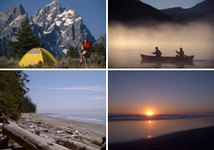The unofficial BC Travel & Tourism Guide
Mount Edziza

At an elevation of 2,787 metres, Mount Edziza is an outstanding feature of this rugged and arresting domain. There are five significant lakes within the park. Buckley Lake is on the northern border; Mowdade, Mowchilla, Kakiddi and Nuttlude form a chain along the eastern boundary. Except Mowdade, all the lakes drain north into the Klastine River, a tributary of the Stikine.
To the south, Raspberry Pass separates the Edziza area from the Spectrum Range. These mountains are named for their brilliant red, yellow, white and purple rock, formed from lava flows. This altered rhyolite resulted from staining by sulphurous mineral waters. Subsequent erosion has resulted in the combination of many hues, giving the landscape the appearance of a vast water- colour painting.
Mount Edziza:
The eruption that built Mount Edziza and its central cone began four million years ago. Mount Edziza, is a composite volcano consisting of thin basalt flows and a central dome of andesite, dacite and rhyolite with a glaciated crater nearly 2,500 metres in diameter. Successive lava flows raised the dome above the encircling plateau and spread lava over an area 65 kilometres by 25 kilometres. The last basalt flow occurred only 10,000 years ago.
Ever since Mount Edziza became dormant, numerous small eruptions have taken place around it, creating more than 30 cinder cones. Perfectly symmetrical Eve Cone rises 150 metres above the plateau, as do Coffee and Cocoa craters.
Recreation:
This isolated wilderness area offers wilderness camping, hiking, fishing, hunting, nature study, and wildlife viewing.
Hikes:
The volcanic cinder cones on Edziza Plateau are delicate and subject to surface scarring from foot traffic. If you must climb Eve’s Cone or other cinder cones, please stay on established routes. A designated route has been established on the north-east ridge of Eve’s Cone.
Wildlife:
Visitors may encounter black and grizzly bears in the park. Grizzlies are occasionally seen above timberline where arctic ground squirrels are abundant. Moose are probably the most common large animals in the area. Small herds of Osborn caribou may be seen in the alpine and sub-alpine vegetation zones on the west side of the plateau between Mount Edziza and the western escarpment. Mountain goats and Stone sheep can often be viewed on the south, east and west slopes of Mount Edziza, particularly on the western escarpment and in the Spectrum Range. Other wildlife to be seen or heard include wolves, large waterfowl, shorebirds, raven, owl, gyrfalcon, ptarmigan (willow and rock), grouse and migratory songbirds. Typical waterfowl species include goldeneye, grebe, white winged scooter and scaup.
History:
The remnants of the Yukon Telegraph line, which was constructed to provide a communications link as far north as Dawson City during the Klondike Gold Rush, still remain in the form of a few poles and collapsed line cabins on the east bank of Mess Creek and through Raspberry Pass area. The trail is now overgrown and no longer passable.
Location and access:
Telegraph Creek to the northwest is the nearest community, and the only road connection to there is via a secondary road to Dease Lake, 113 kilometres northeast on Highway 37. The park is about 500 kilometres north of Kitwanga, on Highway 16. Dease Lake, via Highways 16 and 37, is approximately 600 kilometres north of Terrace. From Dease Lake to Watson Lake is about 245 kilometres. A 50-unit campground is located in Kinaskan Lake Provincial Park, at the south end of the lake and adjacent to Highway 37.
There is no vehicle access into the park. This isolated wilderness area can only be accessed via foot trails or float planes authorized to land within the park. A Letter of Permission is required for individuals or groups who wish to use horses within Mount Edziza Provincial Park. To obtain a Letter of Permission, contact the BC Parks Stikine Area Office at (250) 771-4591.
Mount Edziza Provincial Park has no supplies of any kind.
Safety:
This is an isolated wilderness area with no supplies of any kind and visitors are very much on their own. They should bring suitable clothing offering protection from wind, cold and rain, as well as equipment for outdoor living. Travellers should be equipped with a compass and topographic maps. It should be noted, however, that on the plateau, magnetic properties in the rocks may affect the accuracy of the compass.
Summer is short at Mount Edziza Provincial Park. Although temperatures may hit the 30°C range in mid-summer during the day, it can drop below freezing that same night. Freezing rain and snow are possible any day of the year. Generally, weather suitable for backpacking occurs between July 1 and September 15. Be prepared for adverse weather conditions that can include white-outs and high winds.
Hiking or taking shortcuts through the lava fields is not recommended because it is very difficult and potentially unsafe.
Bear-proof containers are recommended for the safe storage of food above the tree line on the plateau area. There are bear-proof metal caches available for public use located at Mowdade and Buckley Lakes.
Just click on the following links for more information about nearby communities such as
